Great bento box makers: Shibata Yoshinobu Shoten in Odate, Akita, Japan
Odate (pronounced oh-dateh) in the northern prefecture of Akita near the border to Aomori prefecture, is a quiet, rather nondescript town. There are no must-see tourist attractions to speak of, though it's surrounded by some beautiful scenery, and not even much of a history as a town - it was only formed in 1951, by consolidating several villages. However, Odate and its immediate area are known as being the original spot for some famous things: Akita-ken, perhaps the most famous kind of Japanese dog breed; hinai-dori, a very tasty kind of freerange chicken; and kiritanpo, a pounded rice dumpling on a stick. Perhaps most important of all is the dentou kougeihin or Traditional Japanese Craft designation given to Odate magewappa by METI (the Ministry of Economics, Trade and Industry).
A magewappa is a bent wood item or container, made by soaking or steaming long strips of wood and bending it into circular shapes. Odate magewappa is made from the indigenous Akita sugi (often called Akita cedar, though botanically it's a cryptomeria). A magewappa bento box is considered by many Japanese people to be the best container of all for a rice-based bento, since the uncoated Akita sugi wood makes plain rice taste wonderful.
There are several manufacturers of magewappa in Odate, but arguably the best of them all is mayde in this small workshop that is as plain and unassuming as the town they reside in. It belongs to the Shibata Yoshinobu Shoten.
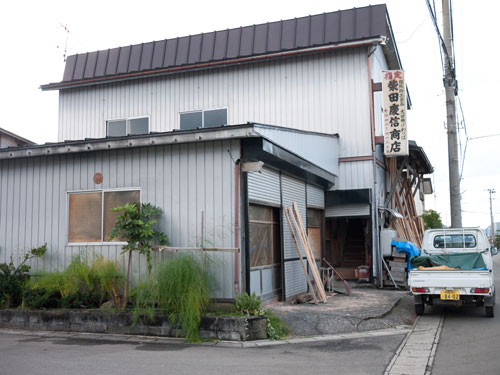
The boss is Mr. Yoshinobu Shibata, who at the age of 71 is still hale and hearty. He no longer sits in the workshop every day, but does make the occasional special item for some favored customers. His sons now run the day-to-day operations, though Mr. Shibata still travels around the country for the various 'traditional wares' fares held in department stores, where most such craft items are sold these days.
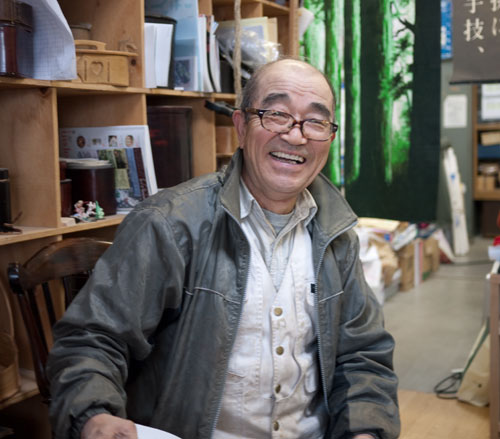
When I took his picture, he was sitting in the small office of the workshop, one wall of which is taken up not by product samples, but by a big shelf filled with bent-wood items from around the world. Some he's collected during his travels around world, and some have been sent to him by his many fans; painted boxes from Scandinavia, drums from Africa, milk pails from eastern Europe, a Shaker sewing box from America.
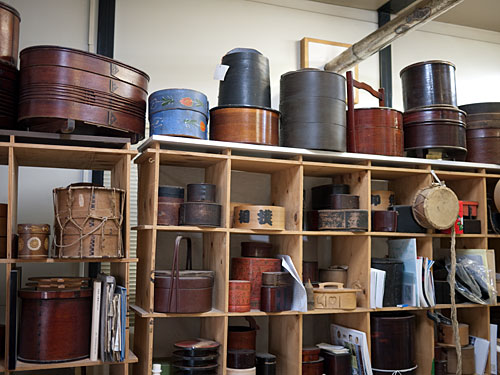
Mr. Shibata has been fascinated by bent wood for almost his whole life. The operation is not a family business he inherited; he was a farmer's son. But he was captured by the magic of magewappa in his youth, which at the time was a slowly dying craft, and he was determined to preserve the tradition. So he opened his workshop in 1964.
Unlike many other magewappa manufacturers, even those in Odate, Shibata Yoshinobu Shoten does not use mass-production machinery. Each strip of wood is cut, planed and steamed using rather primitive equipment, by one skilled workman. This means that the sides of a typical Shibata Yoshinobu box is thicker and more substantial in feeling than their machine-made counterparts.
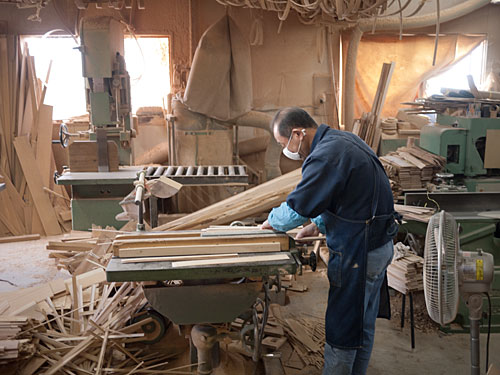
Here's an ohitsu (rice container) split into two to show the construction of a magewappa piece - and the lovely wood grain of the Akita sugi.
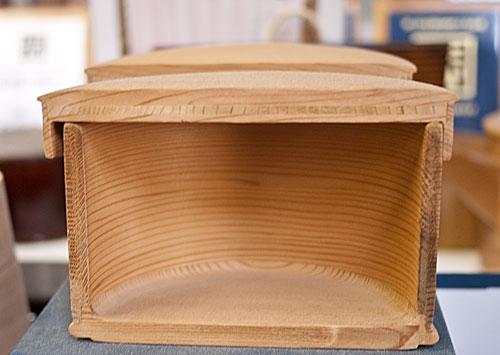
Shibata Yoshinobu Shoten is in fact a very well known company, regarded as one of the best magewappa makers in Japan, if not the best. They have exhibited at several exhibitions worldwide, and won numerous awards. Yet, in their tiny workshop each piece is still put together painstakingly by hand. The workers mostly sit on zabuton (floor mats), face masks and hand towels (tenugui) or scarves protecting their hair and faces from the dust, working in a serene silence, oblivious to the chaotic piles of items all around them, with only the sound of a kettle gently puffing away an old kerosene heater as their background music.



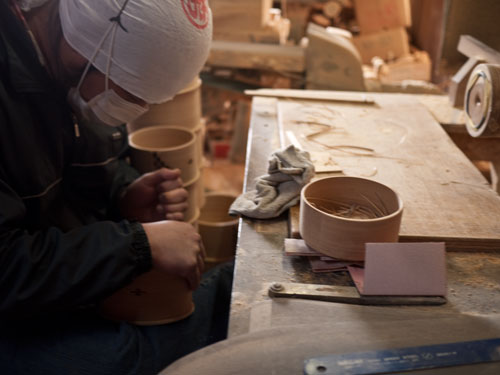
In the olden days, the bent sugi wood was secured simply by threading through and typing thin, tough strips of cherry tree bark. These days, for the sake of durability and practicality the wood is secured with food safe glue - otherwise the sides had a tendency to slowly separate if treated roughly. However, the cherry tree bark lacing is still applied for decorative purposes. Functionally it's no longer necessary, but it adds a feeling of tension and completeness to magewappa piece. A tiny young woman applies the lacing to most of the magewappa wares that emerge from the workshop.

The hands holding this beautiful box belong to one of Mr. Yoshinobu Shibata's daughter-in-laws, who runs the front office and answers all emails, showed me around the workshop. This is a true family business.

A common question asked about these bare-wood magewappa boxes is, how does one take care of them? How long do they last? They are surprisingly durable. In the front office/reception area, they had on display two models of the same bento box, the Tsukushi model, named after Mr. Shibata's first granddaughter. The one of the left is brand new and have never been used. The one of the right is about 10 years old. It has been in heavy use, and scrubbed with a tawashi natural bristle scrubber, then always left to dry completely. (A nylon brush will do the job too.) The wood has darkened and the grain become more prominent, but the box still looks beautiful. The idea is to enjoy the way the wood changes over the years, as its lovingly used and washed again and again.

The store in Asakusa, Tokyo
Odate is frankly a bit hard to get to - from Tokyo you have to take the Shinkansen, then either take two local trains or a long distance bus. But to see the full range of what Shibata Yoshinobu has to offer you only have to go to their small boutique just steps away from the famous Kaminari-mon in Asakusa. The banner on the front of their store says "From Parent to Child, from Child to Grandchild / Odate Magewappa / Shibata Yoshinobu Shoten".
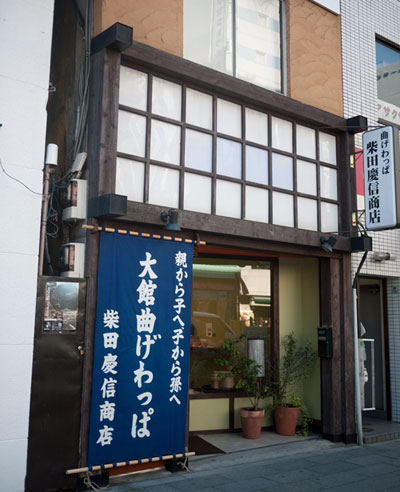
Bento boxes make up about half of their lineup, and start at around 8000 yen and go up from there. Most are bare wood, but some are lacquered.
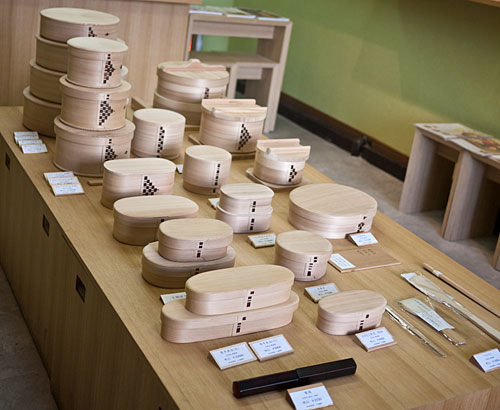
Besides bento boxes, the store also carries traditional implements like rice containers, as well as modern items like a small butter container and a bread plate, both of which won a prestigous Good Design award this year, as did some of their bento boxes. All the shapes are timeless, fitting just about anywhere I think. I have an aunt who has a treasured collection of Shibata Yoshinobu items taking up a whole shelf unit. They are that addictive.

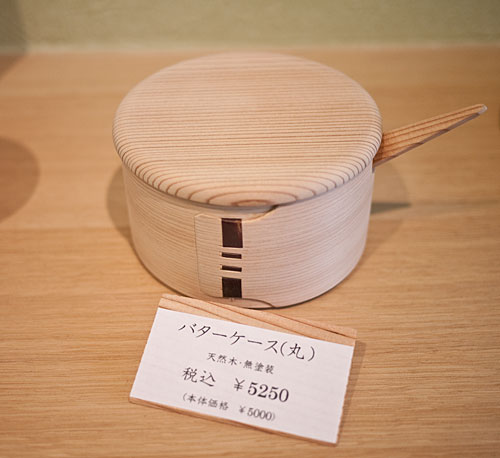
Besides the Asakusa store, Shibata Yoshinobu Shoten has a permanent store within the Nihonbashi Mitsukoshi store, and they also make frequent appearances at traditional craft fairs held in department stores nationwide. The schedule is posted on their website, which is in Japanese only unfortunately.
I don't know if they will ever start to sell their products overseas. I got the feeling that they are operating more or less at capacity at the moment. But who knows? Their magewappa boxes cost 2-3 times what other magewappa boxes do, but they just as much works of art as they are...boxes. I'm very slowly building up a Shibata Yoshinobu collection myself, though it's quite slow going. And when I donated a box from my collection to raise money for Bento4Japan earlier this year, it fetched an amazing US $380. Traditional handcrafts are disappearing from our world so fast, that I feel that if it's within our power to do so, we need to support them as much as we can.
Great Japanese bento makers
This was actually part 2 of a sporadic series about great bento box makers in Japan. Part 1 was about Hakoya. Whether they are working with humble plastic or fine wood, Japanese craftsmen and women take a lot of pride in what they do. A bento box may be just a food container to some, but to me they mean quite a lot more.
(I visited the Yoshinobu Shibata workshop in Odate last year. It's taken me a full year to write this article! Many thanks to Mr. Yoshinobu Shibata and the entire Shibata family as well as the staff at the Asakusa store for their kind cooperation. I can't wait to go back to get another piece for my collection.)
Practical details
- Yoshinobu Shibata Shoten website. Japanese only, but there are many more beautiful photos of their products, so take a look around.
I've marked the location of the Shibata Yoshinobu Asakusa store on my Google map of Tokyo shopping destinations. The address is:
〒111-0034
東京都台東区雷門1-13-10
Tel&Fax : 03-6231-6477
Hours : 10:30~19:00
Closed Wed
It is just down the street from Kaminari-mon, so if you are asking for direction, ask where Kaminari-mon is, then go down the street with Kaminari-mon to your right.
Nihonbashi Mitsukoshi is a huge department store. Just go to the Nihonbashi station (several metro lines stop there) and follow the signs, or just ask for directions.
Shibata Yoshinobu products are carried by several boutiques, but for the most complete selection of products, I recommend going to the Asakusa store or Mitsukoshi.
If you enjoyed this article, please consider supporting this site by becoming my patron via Patreon.
